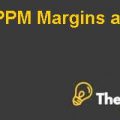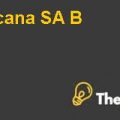
Spyder Active Sports
Introduction
The report presents a case about Spyder Active Sports, a leading supplier of skiwear clothes and accessories, which had enjoyed tremendous growth through a long-standing partnership with CHB Capital Partners, a private equity firm. By 2004, the founder of the company, David Jacobs and CHB was considering the sale of company, which raised issues of the company’s valuation and foreseeable future prospects of Spyder Active Sports.
Case Analysis
Ownership structure and an evaluation of sale perspective
The ownership structure of Spyder comprises of 37.9% share that belongs to CHB. Jacobs and Shimokubo hold a share of 25.4% each, whereas the remaining share of 11.3% belongs to the company’s employees, including Jake Jacobs.
In early 2004, as long as the market improved after serving a downturn in economic conditions, CHB wanted to liquidate its investment and Jacob wanted to harvest some value from his company, so they decided to sale Spyder. The parties were concerned about the feasibility of the options which could increase their worth and were also concerned about the succession and future leadership which would increase the worth of the whole organization.
Evaluation of sale options
Strategic buyers enjoy synergistic benefits from aligning the operations of different business whereas the financial buyers are typically companies which invest money in growing business and are really concerned about their returns. Further, in a minority interest, the parties do not possess the power to influence the operations of the business whereas the controlling parties hold the power to influence the situations.
In order to maximize the value of the company, the organization shall consider to locate a financial buyer which will be interested to hold a minority interest in the company because financial buyer will provide funds to the organization in exchange for the expected return but will not exercise a level of control which will benefit the existing management in performing their duties without experiencing any sort of organizational change.
Other factors impacting the value of Spyder
There are also other factors which may affect the value of Spyder. A controlling premium is the higher amount paid by the acquirer in order to obtain the control of the organization, where the acquirer exercises an important part in the decision-making process. On the other hand, privately owned companies usually face the problem of liquidity discount, where the equity value of the organization is decreased as compared to other publicly traded companies operated under same capacity. Further, the organizations usually want to control business so that they can align different business operations in order to enjoy synergies. In order to account these factors, owners shall consider the ownership and control of the organization and shall adopt a strategy which will benefit the organization while fulfilling their own needs.
Evaluation of valuation techniques
Trading Multiples: Based on our analysis in Appendix 1, the enterprise value based on sales multiple in 2004 represents a figure of $78, 839 and $69,529 whereas considering the EBITDA multiple in 2004 shows a result of $102, 880 and $99,874. The enterprise value calculated on estimated figures of 2005 shows far more better results, considering a sale multiple represents an enterprise value of $109,564 and $96,625 whereas; the EBITDA multiple shows the figure of $147,856 and $143,536
Transaction Multiples: Based on our analysis in Appendix 2, the strategic and financial acquirer’s value based on sales multiple in 2004 represents a figure of $65,468 & $67,883 and $88,152 & $70,799 respectively whereas; considering the EBITDA multiple in 2004 shows a result of $105,039 & $97,391 and $95,417 & $86,974 respectively. The strategic and financial acquirers value calculated on estimated figures of 2005 shows far more better results, considering a sale multiple represents a value of $90,982 & $94,338 and $122,506 & $98,390 respectively whereas the EBITDA multiple shows the figure of $150,959 & $139,968 and $137,131 & $124,997 respectively. The results of both the acquirers for sale and EBITDA in 2004 shows results of $74,542 & $67,883 and $100,762 & $89,166 respectively whereas the sale multiple and EBITDA multiple using both strategies in 2005 shows results of $103,592 & $94,338 and $144,813 & $128,147 respectively.
Discounted Cash Flow: Our analysis in Appendix 3 shows that the company has an enterprise value of $125,931. After considering different approaches for valuation of Spyder, the owners of the company should consider to sale the company within a range of $100 to $125 million.
Conclusion and recommendations
From the perspective of David Jacobs, a financial buyer would be a better option, who provide funds to the organization in exchange for the expected return and David Jacob took the charge of the organization’s operations and lead the organization towards the next frontier of growth but on the other hand, CHB Capital Partners would prefer a strategic buyer, who would pay premium to the existing parties in order to obtain the control over the...............................
This is just a sample partial case solution. Please place the order on the website to order your own originally done case solution.
David Jacobs founded the elite ski clothing company in 1978. He has successfully built and grown the company, a major international brands, which appealed to the ski racers and other active skiers. In 1995, he was looking for external funding to support the continued growth of the company and structuring financial transactions with CHB Capital Partners, a private equity firm in Denver. By 2004, Jacobs was ready to consider alternative forms of equity transactions, which are a source of liquidity for him and his family, including the sale to another company Spyder clothing and sale of a large stake in a private equity firm. Poses questions of estimation is a private company and alternative ways to gather wealth from private companies. Also raises issues of family business, because the transaction will have a significant impact on her two children, who are involved in the business.
Includes color exhibits.
To enhance their effectiveness, color cases should be printed in color. "Hide
by Belen Villalonga, Dwight B. Crane Source: Harvard Business School 23 pages. Publication Date: September 7, 2005. Prod. #: 206027-PDF-ENG











